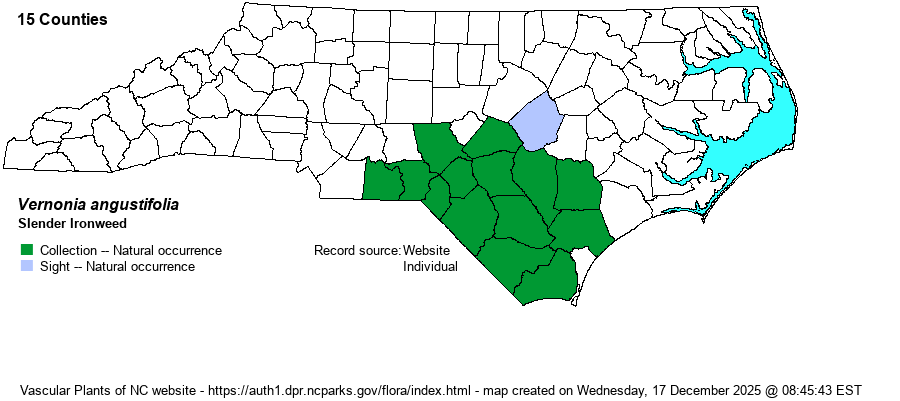| Author | Michaux | |
| Distribution | Sandhills and southern Coastal Plain.
Coastal Plain, NC to southeastern GA. | |
| Abundance | Frequent to common in the Sandhills region, slightly less numerous in the southern Coastal Plain, but still fairly common in many areas. The State Rank probably should be moved from S3 to S4. | |
| Habitat | Dry/xeric to mesic Longleaf Pine-Wiregrass uplands, sandhills, drier savannas, flatwoods. Responds well to recurring fires. | |
| Phenology | Flowering and fruiting late June - early September. | |
| Identification | The very numerous linear leaves and colorful inflorescence produce a handsome plant. The stem typically grows 2-3 feet, with a relatively flat-topped inflorescence of pink to red-purplish heads that lack rays. A large stand of this plant, in bloom, is a major attractant of butterflies and other insects. | |
| Taxonomic Comments | Hybrids with V. acaulis occur in scattered locations and have broad basal leaves and many short stem leaves; they have been given the name V. x georgiana. Weakley (2018) assigns the nominate variety as the one found in NC.
| |
| Other Common Name(s) | Tall Ironweed, Carolina Slender Ironweed, Narrowleaf Ironweed. This species has Tall Ironweed as its most prevalent name, but this is a misnomer, as other species are much taller. Also, V. gigantea -- often still named as V. altissima -- is often rightfully called Tall Ironweed (secondary to the more often used Giant Ironweed). To avoid confusion and to provide a much better name, the website follows Sorrie (2011) and uses Slender Ironweed as the best common name for V. angustifolia. | |
| State Rank | S3? [S4] | |
| Global Rank | G5 | |
| State Status | | |
| US Status | | |
| USACE-agcp | FACU link |
| USACE-emp | FACU link |

